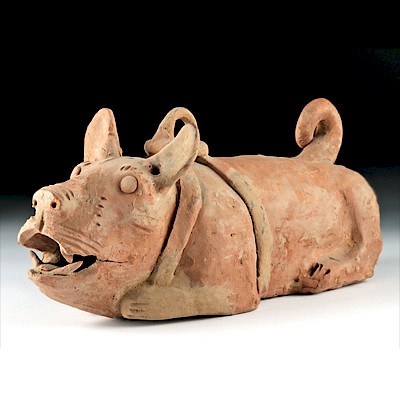Jalisco Ameca-Etzatlan Pottery Seated Female Figure
Lot 71
About Seller
Artemis Gallery
686 S Taylor Ave, Ste 106
Louisville, CO 80027
United States
Selling antiquities, ancient and ethnographic art online since 1993, Artemis Gallery specializes in Classical Antiquities (Egyptian, Greek, Roman, Near Eastern), Asian, Pre-Columbian, African / Tribal / Oceanographic art. Our extensive inventory includes pottery, stone, metal, wood, glass and textil...Read more
Estimate:
$2,500 - $3,500
Absentee vs Live bid
Two ways to bid:
- Leave a max absentee bid and the platform will bid on your behalf up to your maximum bid during the live auction.
- Bid live during the auction and your bids will be submitted real-time to the auctioneer.
Bid Increments
| Price | Bid Increment |
|---|---|
| $0 | $25 |
| $300 | $50 |
| $1,000 | $100 |
| $2,000 | $250 |
| $5,000 | $500 |
| $10,000 | $1,000 |
| $20,000 | $2,500 |
| $50,000 | $5,000 |
| $100,000 | $10,000 |
| $200,000 | $20,000 |
About Auction
By Artemis Gallery
Sep 13, 2018
Set Reminder
2018-09-13 10:00:00
2018-09-13 10:00:00
America/New_York
Bidsquare
Bidsquare : Ancient | Asian | Ethnographic - Fall Variety
https://www.bidsquare.com/auctions/artemis-gallery/ancient-asian-ethnographic---fall-variety-3432
Travel the world and back in time... Antiquities from Egypt, Greece, Italy and the Near East, Asian, Pre-Columbian, African / Tribal / Oceanic, Native American, Spanish Colonial, Russian Icons, Fine Art, much more! Artemis Gallery info@artemisgallery.com
Travel the world and back in time... Antiquities from Egypt, Greece, Italy and the Near East, Asian, Pre-Columbian, African / Tribal / Oceanic, Native American, Spanish Colonial, Russian Icons, Fine Art, much more! Artemis Gallery info@artemisgallery.com
- Lot Description
Pre-Columbian, West Mexico, Jalisco, Ameca-Etzatlan style, Protoclassic period, ca. 100 BCE to 250 CE. An exceptional hollow-built and highly-burnished polychrome pottery figure depicted resting upon bent legs with a knee-length skirt covering her thighs. She sits in an upright pose with outstretched arms flanking her wide torso and globular breasts, and her shoulders are studded with dozens of round cicatrices (ritual scarification marks). Her oversized head boasts an expressive visage characterized by almond eyes with raised pupils, a prominent nose, full lips surrounding bared teeth, large ears adorned with intricate earspools, and a well-sculpted chin, all beneath a tall brow and an elaborate headdress wrapped with a studded strap. Her face is embellished with delineated areas of red and cream slip as is the rest of her body, giving this figure a distinctive appearance evocative of ancient western Mexico! Size: 11.125" W x 14.5" H (28.3 cm x 36.8 cm).
West Mexican shaft tomb figures like this example derive their names from the central architectural feature that we know of from this culture. Jalisco, located on Mexico's southwestern coast, was part of the shaft tomb culture during this time, along with neighbors in nearby Colima and Nayarit. These people would build generally rectangular vertical or near-vertical shafts down from the ground level - usually about 3 to 20 meters deep - through tepetate, the volcanic tuff that makes up the geology of the region, to narrow horizontal tunnels that led to one or more vaulted or rounded burial chambers.
These shafts were almost always dug beneath a dwelling, probably a family home, and seem to have been used as family mausoleums, housing the remains of many related individuals. Figures like this one were placed into the tombs; researchers believe that they were placed around the edges facing inward, as if in conversation with the dead. Grouped with other figures, and alongside clay bowls, and boxes, figures like this one were positioned around the body (or bodies), near the skull.
Unfortunately, we lack the necessary information to fully understand what these figures were made for - Did they represent everyday people, even individuals? Were they religious? Were they created to mediate between the living and the dead? Whatever their purpose, today they are beautiful artwork and reminders of the mysterious past.
For a similar example, please see the Los Angeles County Museum of Art, accession number M.86.296.76: https://collections.lacma.org/node/253625
Provenance: private New York, New York, USA collection; ex-Art for Eternity, New York, New York, USA; ex-private lifetime collection of Dr. Saul Tuttman and Dr. Gregory Siskind, New York, New York, USA
All items legal to buy/sell under U.S. Statute covering cultural patrimony Code 2600, CHAPTER 14, and are guaranteed to be as described or your money back.
A Certificate of Authenticity will accompany all winning bids.
We ship worldwide and handle all shipping in-house for your convenience.
#135419Figure repaired from multiple large pieces with some chips, resurfacing, overpainting, and light adhesive residue along break lines. Surface wear and abrasions commensurate with age, small losses to fingers, ears, nose, and headdress, with fading to some areas of pigmentation, and light roughness across most surfaces. Nice earthen and mineral deposits throughout. Nice craquelure to pigmentation in some areas. Old inventory number written in black ink beneath base.Condition
- Shipping Info
-
All shipping is handled in-house for your convenience. Your invoice from Artemis Gallery will include shipping calculation instructions. If in doubt, please inquire BEFORE bidding for estimated shipping costs for individual items.
-
- Buyer's Premium



 EUR
EUR CAD
CAD AUD
AUD GBP
GBP MXN
MXN HKD
HKD CNY
CNY MYR
MYR SEK
SEK SGD
SGD CHF
CHF THB
THB















